
Gentiana is a genus of flowering plants belonging to the gentian family (Gentianaceae), the tribe Gentianeae, and the monophyletic subtribe Gentianinae. With over 300 species, it is considered a large genus. Gentians are notable for their mostly large trumpet-shaped flowers, which are often of an intense blue hue.

Gentiana acaulis, the stemless gentian, or trumpet gentian, is a species of flowering plant in the family Gentianaceae, native to central and southern Europe, from Spain east to the Balkans, growing especially in mountainous regions, such as the Alps and Pyrenees, at heights of 800–3,000 m (2,625–9,843 ft).

Sympetally is a flower characteristic that historically was used to classify a grouping of plants termed Sympetalae, but this term has been abandoned in newer molecular based classifications, although the grouping has similarity to the modern term asterids.

Gentianella is a plant genus in the gentian family (Gentianaceae). Plants of this genus are known commonly as dwarf gentians.
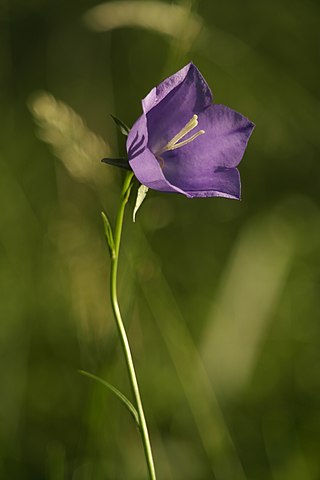
Campanula persicifolia, the peach-leaved bellflower, is a flowering plant species in the family Campanulaceae. It is an herbaceous perennial growing to 1 m. Its flowers are cup-shaped and can be either lilac-blue or white. Its foliage is narrow and glossy with a bright green appearance.
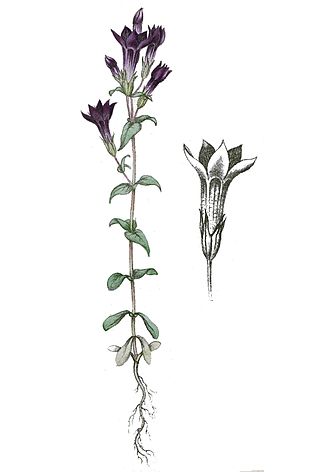
Gentianella amarella, the autumn gentian, autumn dwarf gentian, or autumn felwort, is a short biennial plant flowering plant in the gentian family, Gentianaceae. It is found throughout Northern Europe, the western and northern United States, and Canada.

Gentiana newberryi is a species of gentian known by the common names alpine gentian and Newberry's gentian. It is a perennial herb found in western North America.
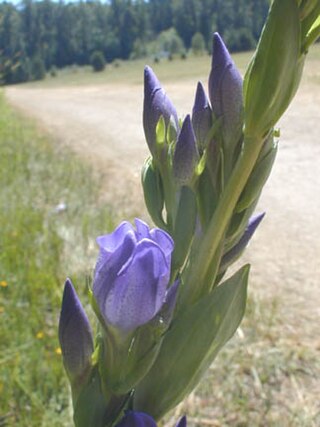
Gentiana sceptrum is a species of flowering plant in the family Gentianaceae. It is known by the common names king's scepter gentian or king's gentian.
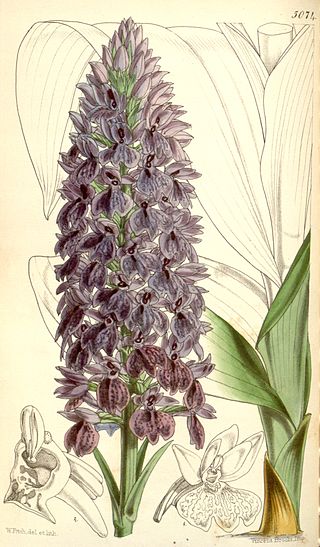
Dactylorhiza foliosa, the Madeira orchid or leafy orchid, is a species of flowering plant in the family Orchidaceae, endemic to the Portuguese Island of Madeira in the eastern Atlantic Ocean. It is a tuberous herbaceous perennial growing to 60 cm (24 in) and producing spikes of intense, magenta-pink flowers in late spring.

Astrantia major, the great masterwort, is a species of flowering plant in the family Apiaceae, native to central and eastern Europe. Growing up to 90 cm (35 in) tall by 45 cm (18 in) broad, it is an herbaceous perennial, much used in gardens.

Hymenodictyon parvifolium Oliv. is a small rubiaceous African tree and is one of some 24 species in the genus, with a tropical African and Asian distribution. This species grows as a small tree to some 5 metres tall, or sometimes a liane or scrambler to 10.5 m, and is found in low-altitude woodland.

Gentiana pannonica, the Hungarian gentian or brown gentian, is a species of flowering plant in the family Gentianaceae.
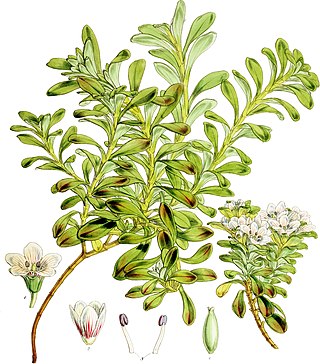
Gentianella cerina is a plant species in the Gentianaceae family, endemic to the Auckland Islands of New Zealand.
Gentiana autumnalis subsp. pennelliana, is a rare subspecies of flowering plant in the gentian family Gentianaceae. It is commonly known as wiregrass gentian and grows in sections of the Florida panhandle.

Cerastium subtriflorum, the Slovenian mouse-ear chickweed, is a perennial plant species in the family Caryophyllaceae. It is mostly restricted to the Slovenian and Italian Alps.

Vicia grandiflora, commonly known as large yellow vetch and bigflower vetch, as well as large-flowered vetch, is a common herbaceous plant species in the family Fabaceae, which occurs as a native plant species in Europe and Asia, as well as an introduced vetch species in North America.

Galeopsis pubescens, also known as the hairy and downy hempnettle, is a herbaceous annual plant species in the family Lamiaceae, that can be found growing in various European countries.
Gentiana bredboensis commonly known as Bredbo gentian, is a flowering plant in the family Gentianaceae and is endemic to New South Wales. It is a small annual herb with white flowers.

Rhinanthus glacialis, commonly known as the aristate yellow rattle or glacier rattle, is a herbaceous plant species in the family Orobanchaceae, formerly classified as a member of the family Scrophulariaceae. This European species is primarily inhabiting the Central Europe.

Gentiana alpina is a plant species from the Gentiana genus in the family Gentianaceae.


























